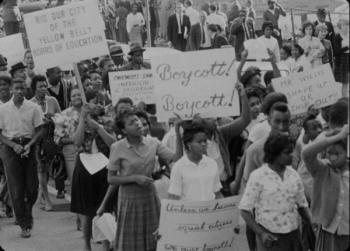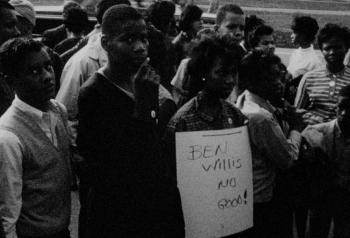what happened to the freedom school on the west side of chicago?
Fifty years ago today, 200,000 Chicagoans boycotted Chicago Public Schools due to the segregationist policies of Superintendent Benjamin Willis. He placed mobile units on playgrounds and parking lots to solve overcrowding in African American schools. These students were also given secondhand books. Read more about the documentary chronicling the protests of Freedom Day on October 22, 1963 and lookout a video clip below.
Why should we commemorate the 1963 Chicago Public Schoolhouse boycott?
Past Rachel Dickson

Ane of the largest and well-nigh overlooked civil rights actions of the 1960's took place in Chicago. On Oct 22, 1963, exactly 50 years agone today, many Chicago organizations that were part of the Analogous Council of Community Organizations (CCCO) staged a school boycott. 250,000 students did non attend school, and at least xx,000 marched on the streets of Chicago.
Virtually school children learn that Brownish v Lath of Education made segregation in schools illegal, simply what they don't larn is that continuing discrimination in housing codes fabricated de facto segregation continue long past that celebrated court decision. In Chicago, the situation in public schools was especially stark, every bit schoolhouse boundary lines were carefully fatigued to avert integrating the public schools. A steady migration of black people fleeing conditions in the South caused extreme overcrowding in the black schools, while white schools oftentimes had empty seats. Some classes had to run into in hallways, and there were non enough books for all the students in the schools.
And so superintendent of schools Benjamin Willis had to do something to address the overcrowding, only instead of allowing students to cantankerous the color barrier, he started placing trailers in the parking lots of the blackness schools. Rosie Simpson of the Englewood customs coined the term, "Willis Wagons." In some schools, the segregation was maintained fifty-fifty within the schoolhouse, such every bit at Waller High School (now Lincoln Park High School), where classes of white children continued to run into inside the building only classes of black children were forced to meet within the trailers. Tensions mounted, and parents started organizing. In some cases, they laid in the dirt overnight to prevent bulldozers from coming to prepare the ground for trailers to be placed.

These deportment began a wave of larger protests against the systemic and blatant racism which permeated the state. In Feb of 1964, New York Urban center had an even larger school cold-shoulder. In 1966, Reverend Martin Luther King moved his family unit to Chicago to brainstorm the Southern Christian Leadership Council'due south Chicago Freedom Motility, a entrada expanding their civil rights activities from the Due south to Northern cities, using irenic methods to address the complex economic exploitation of African Americans in the Northward. King cited the public school boycott and the CCCO's organizing work as reasons for coming to Chicago. In 1966, later a march in a white neighborhood on the w side of Chicago in which onlookers threw bricks and bottles at the black demonstrators, King said ''I have seen many demonstrations in the south just I have never seen annihilation then hostile and so hateful every bit I've seen hither today.''
Fifty years subsequently, Chicago continues to be one of the about segregated cities in the country. Many people say nothing has changed. Others say Chicago has just gotten worse. Kartemquin Films, the Chicago documentary powerhouse that made Hoop Dreams and The Interrupters, is now making a documentary film about the 1963 Boycott that's due to air on PBS in the spring of 2014. Fifty years ago director Gordon Quinn filmed the march as a 21-twelvemonth former student at the University of Chicago. He's looking for participants in the boycott through the interactive website 63boycott.com. The memory and power of that twenty-four hour period continues to haunt Quinn equally he hunts downwards the participants to interview them virtually what the boycott meant to them. In his interview for '63 Boycott, Chicago community organizer Bob Lucas told Quinn that "The education in Chicago today in the black community is as bad now as it was and then."
Indeed, though some details accept changed, much of the schoolhouse segregation and unfair resourcing of pubic didactics remains. Now, the systematic decimation of public housing has uprooted blackness communities and displaced many. The resulting low enrollments gives the city fathers grounds to say the schools are underutilized and this inefficient use of space means these schools must be closed. Never heed that at the same time that CPS is closing schools they are accepting proposals for new lease schools. In fact, the move toward privatization and charters is another gene leading to depression enrollments. In Chicago and other urban areas, nosotros now see "schoolhouse deserts," or entire neighborhoods where there are no schools, or but charters. Not surprisingly, these are the predominantly black neighborhoods whose schools have been closed.
The 1963 Cold-shoulder is a day worth remembering and learning from. Parents in the blackness customs protested non-violently en masse and made their voices heard. Chicago Public Schools was forced to release a racial headcount of the schools, showing the extreme segregation in the city. CPS also lost a lot of money due to the depression omnipresence rates that 24-hour interval, and Willis eventually retired early a few years later. The Willis Wagons lived on, although some were taken away many remained for years.
Fifty years later, Chicago remains at the forefront of education struggles. Final year Chicago saw the starting time teachers strike in 25 years—an impressive scarlet sea took to the streets enervating ameliorate conditions for teachers and students. This year students, teachers, and parents protested the closing of fifty public schools in Chicago. Students and parents staged walkouts, protests, and boycotts. The lessons we have to learn from 1963 are many, and for many, just as important equally ever.
Source: https://news.wttw.com/2013/10/22/1963-chicago-public-school-boycott
0 Response to "what happened to the freedom school on the west side of chicago?"
Post a Comment